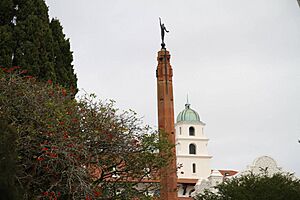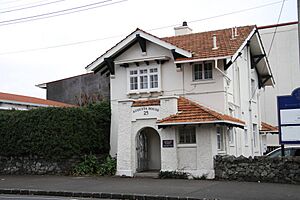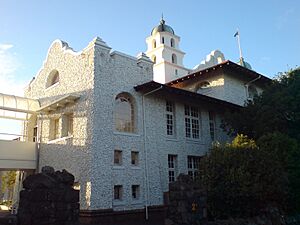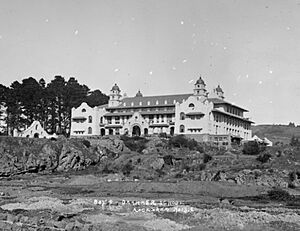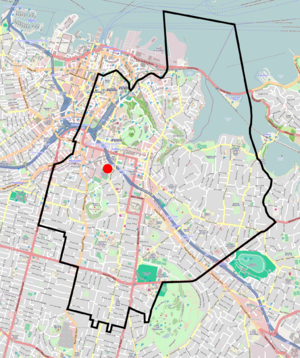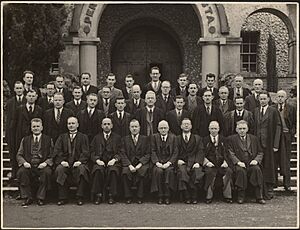Auckland Grammar School facts for kids
Quick facts for kids Auckland Grammar School |
|
|---|---|
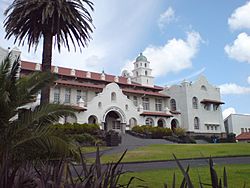
The school is built in Spanish Mission style architecture.
|
|
| Address | |
|
Mountain Road, Epsom
, 1023
New Zealand
|
|
| Coordinates | 36°52′9″S 174°46′10″E / 36.86917°S 174.76944°E |
| Information | |
| Other names |
|
| Type | State, day and boarding secondary school |
| Motto | Latin: Per Angusta ad Augusta (Through difficulties to greatness) |
| Established | 1869 |
| Sister school | Epsom Girls' Grammar School |
| Ministry of Education Institution no. | 54 |
| Chairman | Mark Sandelin |
| Headmaster | Tim O'Connor |
| Years | 9–13 |
| Gender | Boys |
| School roll | 2,664 (February 2024) |
| Colour(s) | Navy blue and gold |
| Socio-economic decile | 9 |
Auckland Grammar School, also known as Auckland Grammar or just Grammar, is a school for boys in Auckland, New Zealand. It was started in 1869. It is a state school, meaning it is funded by the government. Students can attend as day students or live at the school as boarding students.
Auckland Grammar is a secondary school, teaching boys from Year 9 to Year 13. The school has helped more of its students become members of New Zealand's national rugby team, the All Blacks, than any other school in the country. Many students have also won Rhodes Scholarships to study at Oxford University.
The school first opened on Howe Street in Freeman’s Bay. This is where Auckland Girls Grammar School is now. In 1916, Auckland Grammar moved to its current location on Mountain Road in Epsom. In 2020, it had 2606 students, making it one of the largest schools in New Zealand. The current headmaster, Tim O’Connor, started in 2012.
Contents
School History
Auckland Grammar School was given land and money to start in 1850 by Sir George Grey. He was the Governor of New Zealand at the time. Sir George Grey also helped start other schools in New Zealand and South Africa.
The school was officially recognized in 1868 and opened in 1869. It started with 78 boys at the old Immigration Barracks site on Howe Street. At first, the school was paid for by private money. New Zealand did not have a government-funded education system until 1877.
Because more and more students joined, the school moved twice in the 1870s. In 1880, it moved to Symonds Street and stayed there for 35 years. Today, this site is part of the University of Auckland. During an economic downturn in the 1880s, girls from Girls High School joined the school. It was then called the Auckland College and Grammar School.
In 1909, Auckland Girls Grammar School opened on the original Howe Street site. Auckland Grammar School then became an all-boys school again. In 1916, the school moved to its current home on Mountain Road in Epsom. The Governor General, Arthur Foljambe, opened the new school.
The buildings at Auckland Grammar School include important historic places. The main building and a war memorial are listed as Category I historic places. The old janitor's house is a Category II historic place. An obelisk in front of the school remembers former students who fought in wars. The main building, built in 1916, has a Spanish Mission style. It is used for daily meetings and has classrooms on two levels. Inside the main hall, where students meet, are boards listing the school's top students.
In the early 1900s, prisoners from the nearby Mount Eden Prison helped build the 1916 school building. They worked at stone quarries next to the school. The flat land from these quarries was later turned into sports fields for Auckland Grammar School.
The school also owns a place called VentureLodge in Ohakune. Students use this facility for school camps.
The school's motto is in Latin: Per Angusta ad Augusta. This means "Through difficulties to greatness." The school also translates it as "Through rough ravines to hallowed heights." The exact origin of the motto is not known, but it was a common saying when the school was founded.
A TV show about the school, called Grammar Boys, was shown in July 2005 on TV3.
School Buildings
The main school building was built in 1916. It was designed by the architects Arnold & Abbott. This building and the caretaker's house next to it are in the Spanish Mission style. After the main building was finished, three smaller buildings were built in the same style. These included the library, the gymnasium, and a toilet block. The main building is listed as a Category I Historic Place by Heritage New Zealand.
In the 1950s, a large science building was added in a modern style. In the early 1970s, another concrete building was built. A large gymnasium was constructed in the mid-1970s and opened by the Prime Minister at the time, Robert Muldoon.
Near the 1920s Spanish Mission-style library are the Centennial Theatre (opened in 1969) and the swimming pool. The construction of the Motorway in the 1960s took away some of the school's land. Between the 1970s and 2015, many temporary classrooms were built to fit the growing number of students. Most of these have now been removed.
Because some playing space was lost, new sports fields were made in two old quarries. Each field has a sports pavilion. The pavilion on the upper field was rebuilt recently. Between 2014 and 2015, the old toilet block was replaced with a new building for classrooms.
The school's 150th anniversary project is called Te Ara Matauranga. This plan includes a new library, swimming pool, and study block. These will be located between the Centennial Theatre and the War Memorial.
Student Enrolment
As of August 2025, Auckland Grammar School has 2,664 students. Of these, students (Expression error: Unexpected / operator.Expression error: Unexpected / operator.Expression error: Unexpected / operator.Expression error: Unexpected / operator.Expression error: Unexpected / operator.Expression error: Unexpected / operator.Expression error: Unexpected / operator.Expression error: Unexpected / operator.Expression error: Unexpected / operator.Expression error: Unexpected / operator.Expression error: Unexpected / operator.Expression error: Unexpected / operator.Expression error: Unexpected / operator.%) are Māori.
The school has an Equity Index of 386. This means its students face fewest socioeconomic barriers to learning. This is similar to schools that used to be called decile 9 or 10.
In the past, students had to pass tests to get into the school. Since the 1960s, the school has had a "zone." This means students living in a certain area get first choice to attend. Brothers of current students who live outside the zone also get preference. The school believes that having a zone makes house prices higher in that area. This can make it harder for students from families with less money to attend. Research shows that houses in the school zone can cost about $257,000 more.
Auckland Grammar asks for the highest voluntary donation of any non-private state school in New Zealand. In 2014, the suggested donation was $1,050 per student each year. The school says this high donation helps cover the difference in government funding. For example, Epsom Girls' Grammar School, a similar school for girls, asks for a donation of $665.
International students who want to attend Auckland Grammar are tested on their English skills. Some may need to take an intensive English course before starting. International students at Auckland Grammar School pay the highest tuition fees among New Zealand state schools, over $20,000 each year.
Education at Auckland Grammar
Auckland Grammar School follows the New Zealand Curriculum (NZC), which is the national curriculum for schools in New Zealand.
Academic Results
In 2015, many students leaving Auckland Grammar achieved high academic levels. For example, 95.1% of students reached at least NCEA Level 1 or IGCSE. This was higher than the national average for boys.
In 2011, Metro magazine reported that Auckland Grammar's academic results were similar to most private schools. The school also did very well in the National Scholarship exams. The Education Review Office said in 2016 that the school continued to help its students achieve great results. In 2019, it was ranked seventh among New Zealand schools for getting into top universities.
NCEA and Cambridge Exams
The previous headmaster, John Morris, did not agree with the NCEA system. Because the school felt the NCEA system was not well designed, it started offering Cambridge International Examinations in 2002. More talented students could take IGCSE, AS Level, and A2 exams. Other students took NCEA exams. Students in Cambridge classes could switch to NCEA, but this was usually not encouraged. Over the years, most students were encouraged to take Cambridge qualifications.
The school was also cautious about the New Zealand Scholarship. It encouraged only the very best students to try for it. Even so, Auckland Grammar had the most scholarships of any school in New Zealand in 2006.
The 2008 Education Review Office report said that Auckland Grammar was one of the best-performing schools in New Zealand based on national and international exam results. From 2011, the school offered the Cambridge CIE Form 5 program to all students in Form 5. From 2019, the school replaced all external exams for Fifth Formers with its own qualification called Pre-Q. This was in response to planned changes to NCEA. Pre-Q was designed to be "more rigorous than IGCSE."
School Song
The school song was first sung in March 1955. The words were written in 1954 by L. W. A. Crawley, a Classics lecturer at Auckland University College. The song has two verses in Latin and includes the school motto. It is sung to the tune of the German hymn "Ein feste Burg ist unser Gott" ("A Mighty Fortress Is Our God").
School Leadership
Headmasters
Here are the headmasters who have led Auckland Grammar School:
| Period | Headmaster |
|---|---|
| 1869–1870 | Dr Robert Boyd Kidd |
| 1871–1882 | Farquhar Macrae |
| 1882–1892 | Charles Frederick Bourne |
| 1893–1922 | James William Tibbs |
| 1922–1928 | James Drummond |
| 1928–1935 | Harold James Del Monte Mahon |
| 1935–1954 | Colin McGregor Littlejohn |
| 1954–1972 | Sir Henry Cooper |
| 1973–1993 | Sir John Graham |
| 1994–2012 | John Morris |
| 2012–present | Tim O'Connor |
Chairmen of the Board of Trustees
These people have been the Chairmen of the Auckland Grammar School Board of Trustees:
| Period | Chairman of the Board of Trustees |
|---|---|
| 1984–1992 | B.F. Connell |
| 1992–1997 | Prof. Alastair MacCormick |
| 1998–2009 | Dr. Robert B. Kirkpatrick |
| 2009–2019 | A. Jeff Blackburn |
| 2019–present | Mark Sandelin |
Famous Former Students
Auckland Grammar School has had many notable students who went on to achieve great things.
Academia
- Raymond Firth – a famous expert on cultures
- Vaughan Jones – a well-known mathematician
- Richard Cockburn Maclaurin – a physicist and president of the Massachusetts Institute of Technology
The Arts
- Charles Frederick Goldie – a famous artist
- Zane Lowe – a DJ and TV presenter
- Andrew Niccol – a screenwriter and director
- Graeme Revell – a musician and composer
Business
- Richard Chandler – a billionaire investor
- Ian Narev – a chief executive officer of SEEK
Literature
- A. R. D. Fairburn – a poet
- R. A. K. Mason – a poet
Military
- Cyril Bassett – a recipient of the Victoria Cross, a very high military award
Public Service
- Francis Bell – a lawyer and former Prime Minister of New Zealand
- Wayne Brown – the Mayor of Auckland
- Roger Douglas – a politician and former Minister of Finance
- Jonathan Hunt – a politician and former Speaker of the House of Representatives
- Kenneth Keith – a judge
- David Seymour – a politician and Member of Parliament
- Lockwood Smith – a politician and former Speaker of the House of Representatives
Science
- Peter Gluckman – a scientist
- Graham Liggins – a medical scientist
Sport
As of 2015, Auckland Grammar has produced more than 50 All Blacks, which is the most of any New Zealand school.
- Nicky Allen – All Blacks player
- Ben Atiga – All Blacks player
- Hamish Carter – a triathlete
- Jeff Crowe – a cricketer
- Martin Crowe – a cricketer
- John Drake – All Blacks player
- Lockie Ferguson – a cricketer
- Grant Fox – All Blacks player
- Aaron Gate – a racing cyclist
- Edmund Hillary – a famous mountaineer and explorer
- Doug Howlett – a rugby union player
- Akira Ioane – All Blacks player
- Rieko Ioane – All Blacks player
- Kyle Jamieson – a cricketer
- James Neesham – a cricketer
- Dion Nash – a cricketer
- Benson Stanley – All Blacks player
- Jeremy Stanley – All Blacks player
- Kel Tremain – All Blacks player
- Sam Webster – a track cyclist
- Alan Whetton – All Blacks player
- Gary Whetton – All Blacks player
- Wilson Whineray – All Blacks player
Notable Staff
- Henry Cooper – former headmaster
- John Graham – former rugby player and headmaster
- Graham Henry – former teacher and rugby coach for the All Blacks
- John Morris – former footballer and headmaster
See also
 In Spanish: Auckland Grammar School para niños
In Spanish: Auckland Grammar School para niños


